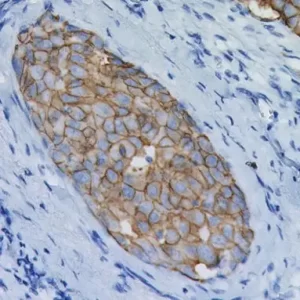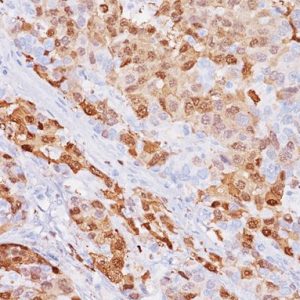Description
CD44 is a transmembranous glycoprotein (80 kDa) responsible for cell adhesion that is expressed in a wide range of normal tissues, such as tonsil, breast, prostate, skin, bladder and cervical squamous epithelium (1). Studies have shown that CD44, also known as HCAM, plays an important role in the cascade of metastasis and progression of human malignant tumors (2). In breast cancer studies, evaluation of CD44 expression has been useful in the differentiation of benign and malignant papillary lesions (2). Expression of CD44s, the most common CD44 isoform, has been reported to be associated with increased survival of patients with nodenegative invasive breast carcinoma (3). Further studies have shown a subpopulation of CD44+/CD24- in breast cancer cells have stem/progenitor cell properties (4).
SPECIFICATIONS
Specifications
| WEIGHT | N/A |
|---|---|
| DIMENSIONS | N/A |
| INTENDED USE | IVD |
| SPECIES REACTIVITY | Human |
| SOURCE | Mouse Monoclonal |
| CLONE | 156-3C11 |
| ISOTYPE | IgG2a |
| ANTIGEN | CD44 |
| LOCALIZATION | Cytoplasmic/cell membrane |
| POSITIVE CONTROL | Breast cancer or tonsil |
DATASHEETS & SDS
INTERNATIONAL
REFERENCES
1. Balic M, et al. Clin Cancer Res. 2006 Oct; 12(19):5615-21.
2. Diaz LK, et al. Clin Cancer Res. 2005 May; 11(9):3309-14.
3. Tse GM, et al. J Clin Path. 2005 Nov; 58(11):1185-8.







Reviews
There are no reviews yet.